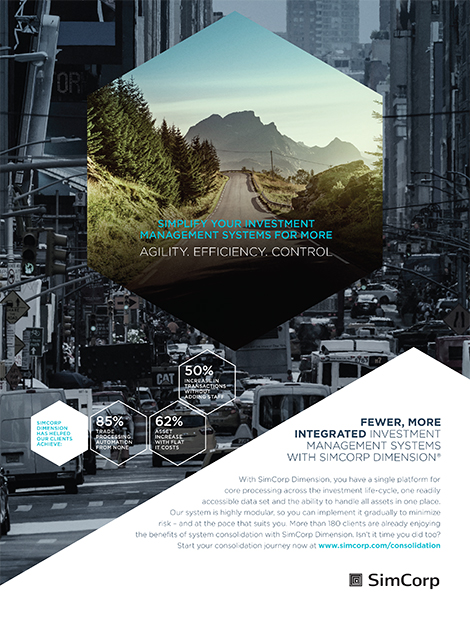How important is it for firms to have a successful, transparent post-trade programme, especially post-financial crisis? Can a firm survive without one?
Robust and comprehensive post-trade reporting processes are clearly becoming more business critical for investment firms. Since post-trade reporting is a daily activity, it requires a sound and scalable operational setup, otherwise it’s not possible to provide regulators with the required range of information, in high quality and in a timely manner, day after day.
The regulatory texts for reporting regimes, such as Markets in Financial Instruments Regulation (MiFIR) and the upcoming Securities Financing Transactions Regulation (SFTR), very clearly define that investment firms are responsible for continuously monitoring reporting quality, identify and resolve issues, and adapt data management and reporting processes, in order to comply with the latest changes to the technical implementation of the reporting regimes.
Last month the Financial Conduct Authority (FCA) levied substantial fines under the second Markets in Financial Instruments Directive (MiFID) transaction reporting regime to UBS and Goldman Sachs. Together with other FCA commentary about the enforcement of the second Markets in Financial Instruments Directive (MiFID II) requirements, this shows that post-trade reporting quality is monitored closely by regulators and firms are expected to comply.
Looking at the recent fines issued by FCA, it becomes clear that even small or medium-sized investment firms can easily face large fines if found to be reporting wrongly over a prolonged period of time.
How have regulators helped/guided firms to achieve better post-trade services? What else could they be doing?
Naturally, complex reporting regimes like MiFIR and SFTR create countless questions about the operational and technical practicalities of daily reporting. The regulator, specifically European Securities and Markets Authority (ESMA), has provided extensive Level 3 texts for MiFIR to address many questions by the industry.
Unfortunately, the European legislative process often prevents that these detailed Level 3 texts are available early since they can’t be published before the Level 2 texts. But it’s fair to say that the industry as a whole has learned how to engage better with the regulators, either individually or through relevant industry associations.
And there seems to be a better understanding by the regulators of the operational and technical complexities associated with building compliance for post-trade reporting regimes. Still, earlier visibility of implementation guidelines would help all involved parties.
What opportunities/challenges does a good level of post-trade transparency bring for the industry as a whole?
Typically, regulatory post-trade reporting draws on many data points that become available as part of the normal post-trade processing and trade enrichment at an investment firm. Hence, it’s important that post-trade reporting processes are an integrated part of the wider post-trade operations set up at any firm.
Otherwise, data will be processed inconsistently and changes to operational data flows will not be reflected in the regulatory reporting flow, and vice versa. But this dependency shows that implementation of good and robust regulatory reporting processes can lead to improved operational processes in general.
How can firms achieve low-risk and low-cost post-trading, especially within Europe and the US, while still meeting the relevant regulations?
With SFTR go-live in April 2020, the triangle of European transaction reporting regimes (after EMIR and MiFIR) will be complete. Despite their differences, these regimes establish similar operational concepts and data requirements, giving firms an opportunity to leverage synergies on an operational level.
At the very least firms should use the same technology stack for complying with these three regimes. Ideally, firms can establish operational processes that leverage existing post-trade operations teams, rather than having segregated teams for operations and regulatory reporting.
Cloud full-service solutions will play a pivotal role in helping firms to achieve a low total cost of ownership for regulatory reporting. Each new regulation requires a significant upfront investment to adapt in-house systems and processes to comply with the new regulatory rules. At the same time, the technical details of each regulatory regime changes frequently. For example, under EMIR there is a relevant technical change every four to eight weeks, due to new guidance from ESMA or additional validation requirements implemented by trade repositories.
Unless investment firms keep deep and expensive regulatory expertise in-house, it is impossible to digest this information and update systems and processes in a timely manner. Dedicated cloud full-service solutions allow firms to subscribe to an ‘always compliant’ regulatory solution.
The solution vendor takes ownership of defining, operating, updating, and testing the regulatory reporting solution. This subscription model to regulatory compliance is becoming more and more accepted by firms, but also by the regulators.
SimCorp, for instance, has developed a cloud-based SFTR Solution for its clients, to provide simplified implementation ahead of the 2020 deadline, with on-going regulatory guidance.
The solution, which is integrated to SimCorp Dimension’s Investment Book of Record (IBOR) delivers the buy side, automation of daily report processes, validation of trade data against the regulatory rule set and a consistent overview across all business processes, to achieve reporting quality close to 100 percent.
Do you think the level of innovation within post-trade is where it should be?
I agree that many firms still haven’t tackled the challenge of technological innovation. One reason is that the technology platform for many in the investment industry is still based on best-of-breed architectures and legacy components that are insufficiently integrated with each other.
This makes technological innovation difficult and hampers the adoption of modern technology for tackling the many challenges with regulatory reporting. That said, regulations such as SFTR can trigger productive and constructive change, including competitive advantage, which may create further interest in the market.
For example, taking a consolidated approach (rather a patchwork approach) to regulations can make all the difference. For one, it enables firms to pool data and use a centralised investment book of record both for processing and reporting.
This increased organisational transparency can also be leveraged in business workflows around securities financing, be it optimisation of collateral or cross collateralisation between over the counters and securities financing transactions (if you clear them on the same central counterparties). That’s something that can make a significant and positive impact on your bottom line.



